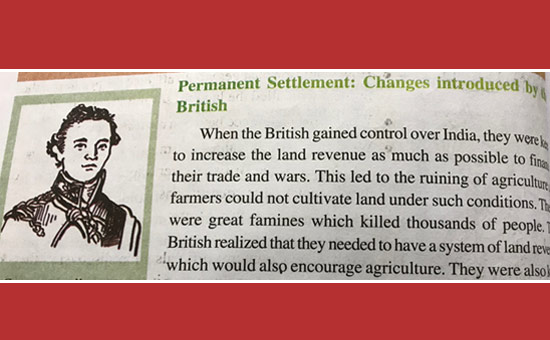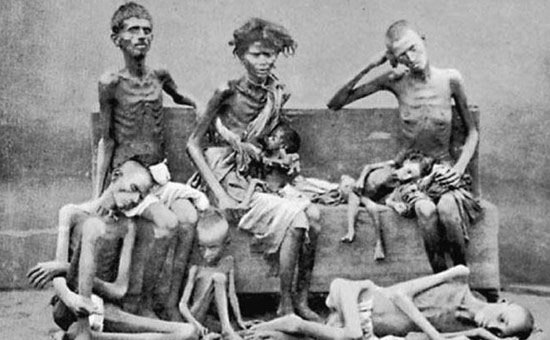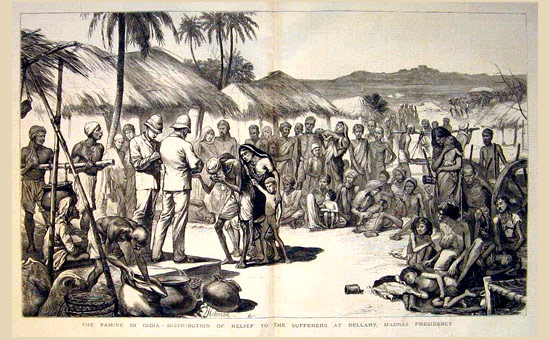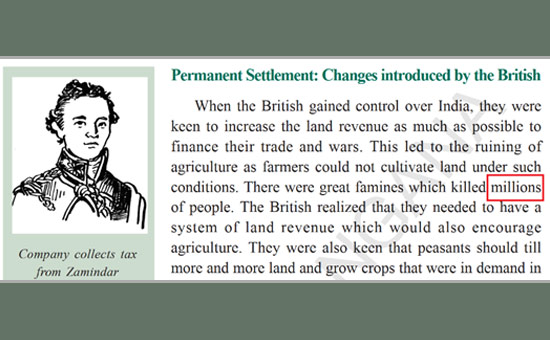-
More
than 50 million died in famines during British rule, yet many school text books
do not mention about them, or say thousands died. Read all about the famines.
To read the same article in Tamil please click on PDF.
Our
team was asked by a State Government SCERT Textbook Board to review 6 to 8
standard Social Sciences textbook. We
made many recommendations for change of content. The State adopted about half
of those suggestions. Let us look at one
example.
In the
context of the Zamindari system, take a look at the following extract from the 8th standard textbook
1

It is true that the British policies ruined our agricultural system. But let us draw our attention to the sentence “There were great famines which killed thousands of people”.
A
famine is a situation where there is an extreme scarcity of food, especially
grains. Many of us many not have had a
first hand-experience of a famine because the last famine was in 1943. However, much research has been done on the
study of famines in India, especially during the colonial period.
In
an important book Late Victorian Holocausts 2, summarized by Fred Magdoff
3, Mike Davis mentions that there were 17 famines in the 2,000 years before British rule. In comparison, in the 120 years of British rule, there were 31 serious famines. Davis argues that the seeds of underdevelopment in what later became known as the Third World were sown in this era of High Imperialism, as the price for capitalist modernization was paid in the currency of millions of peasants’ lives. This fact should impel us to understand the British role in creating intense famines in India.
Here
is a list of some major famines
during British rule in India. 4
|
Year
|
Name
|
Region
|
Deaths
|
Comment
|
|
1769–70
|
Great Bengal Famine
|
Bihar, Northern and Central Bengal
|
10 Million
|
About one third of the then population
of Bengal
|
|
1783–84
|
Chalisa famine
|
Delhi, UP, Punjab, Rajasthan,
Kashmir
|
11 Million
|
Severe famine. Large areas were depopulated.
|
|
1791–92
|
Doji bara famine or Skull
famine
|
Hyderabad, Central
India, Deccan, Gujarat, Southern Rajasthan
|
11 Million
|
One of the most severe famines known.
People died in such numbers that they could not be cremated or buried.
|
|
1860–61
|
Upper Doab
|
Rajasthan
|
2 Million
|
|
|
1865-67
|
Orissa famine
|
Bihar, Orissa, Parts of Southern
India
|
1 Million
|
The British Secretary of State for
India, Lord Salisbury, did nothing for two months, by which time a million
people had died
|
|
1868–70
|
Rajputana famine
|
Rajasthan
|
1.5 Million
|
|
|
1876–78
|
Great Madras Famine
|
Mysore and Hyderabad States (Madras
Presidency)
|
6-10 Mil
|
|
|
1896–97
|
Indian famine
|
Rajasthan, parts of Central India and
Hyderabad
|
5 Million
|
|
|
1943–44
|
Bengal famine
|
Bengal
|
3.6 Million
|
1.5 from starvation; 2.1 from epidemics.
|
In
an 1883 Volume on Rural Bengal 5, W. Hunter gives a vivid and disturbing picture of the 1770 Bengal Famine, “All through the stifling summer of 1770 the people went on dying. The husbandmen sold their cattle; they sold their implements of agriculture; they devoured their seed-grain; they sold their sons and daughters, till … no buyer of children could be found; they ate the leaves of trees and the grass of the field; and in June, 1770, the Resident at the Durbar affirmed that the living were feeding on the dead.
Day and night a torrent of famished and disease-stricken wretches poured into the great cities. …pestilence had broken out. … we find small-pox at Moorshedabad, ... The streets were blocked up with … heaps of the dying and dead. … even the dogs and jackals, the public scavengers of the East, became unable to accomplish their revolting work, and the multitude of mangled and festering corpses at length threatened the existence of the citizens.
Starving and shelter less crowds crawled despairingly from one deserted village to another in a vain search for food, or a resting-place in which to hide themselves from the rain. The epidemics incident to the season were thus spread over the whole country; ... Millions of famished wretches died in the struggle to live ... their last gaze being probably fixed on the densely-covered fields that would ripen only a little too late for them…”
About a quarter to a third of the population of Bengal starved to death in about a ten-month period. In 1865–66, severe drought struck Odisha and was met by British official inaction.
 Victims pictured in 1877 Reference 4.
Victims pictured in 1877 Reference 4.
 Relief Distribution in Bellary Reference 4. Great Famine 1876 to 78.
Relief Distribution in Bellary Reference 4. Great Famine 1876 to 78.
An important work to understand the role of British during the period 1939-45 (World War II), is Madhusree Mukerjee’s book “Churchill’s Secret War” 6 where she shows that the 20th Century’s greatest hero is also its greatest villain.
When asked to release more grain to India, Churchill said “I hate Indians. They are a beastly people with a beastly religion. The famine was their own fault for breeding like rabbits.” When the Delhi Government sent a telegram to him painting a picture of the horrible devastation and the number of people who had died, his only response was, “Then why hasn’t (Mahatma) Gandhi died yet?"
How to
imagine the scale of loss?
The Gaja
cyclone of Tamil Nadu in November 2018, which devastated the livelihoods of
500,000 families by leveling coconut, cashew and mango farms killed about 40
people. The 2004 Tsunami killed 230,000 across 14 countries.
The number of Indians who died in famines in Colonial India is 50
million. The scale of loss is incomparable.
What can India do now?
Indian
school textbooks should bring out British brutality unambiguously, as these
were facts of our history. In the absence of critique of the colonial period,
students can come away with the false notion that colonization was the best
thing that happened to India.

After our team sent this critique to the State, the Editorial Board replaced one word “thousands” by the word ‘millions” 1. While this is welcome, the text makes it
appear that the British rule was benevolent to India. That view needs to be refuted
and completely restated that the British were disinterested in the welfare of
India!
We can also learn from the West. For example, to memorialize the Jewish Holocaust (where close to 6 Million Jews were deliberately killed in Europe during 1941-45), the US has a museum – called the United States Holocaust Memorial Museum in
Washington, D.C. In addition, almost every child going to school in this world
likely learns about the Holocaust.
 The infamous Gas Chambers of the Nazi Holocaust Ref 8
n Holocaust Museum USA Ref 9.
The infamous Gas Chambers of the Nazi Holocaust Ref 8
n Holocaust Museum USA Ref 9.
India
should establish monuments in West Bengal and other places to memorialize this
genocide that killed as many people as the World War I (40 Million), and World
War II (60 Million).
What
were factors contributing to an increased incidence and severity of famines
during the British rule of India? We
will review this in a future article.
References
1. Social
Studies, Class VIII, Hyderabad: SCERT, Telangana, 2018.
2. M. Davis, Late Victorian Holocausts: El Niño Famines and the Making of the Third World, Verso Books, 2017.
3. F. Magdoff, "Late Victorian Holocausts: El Niño Famines and the Making of the Third World. By Mike Davis 2001. Verso, London and New York," Renewable Agriculture and Food Systems, vol. 20, pp. 190-192, 2007.
4. "Timelines of Major Famines in India during British Rule." (Online).
5. W. W. Hunter, "Annals Of Rural Bengal," vol. 1, 1883.
6. M. Mukerjee, Churchill's Secret War: The British Empire and the Ravaging of India during World War II, India Penguin, 2018.
7."Bengal famine of 1943". To read Bengal
famine and Responsibility
for Holocaust
8. G. Will,
"A showcase of the vilest and noblest manifestations of humanity," 26
April 2018. To read